International Swimming League Debrief. Part 1: The Upside Of The First ISL Season
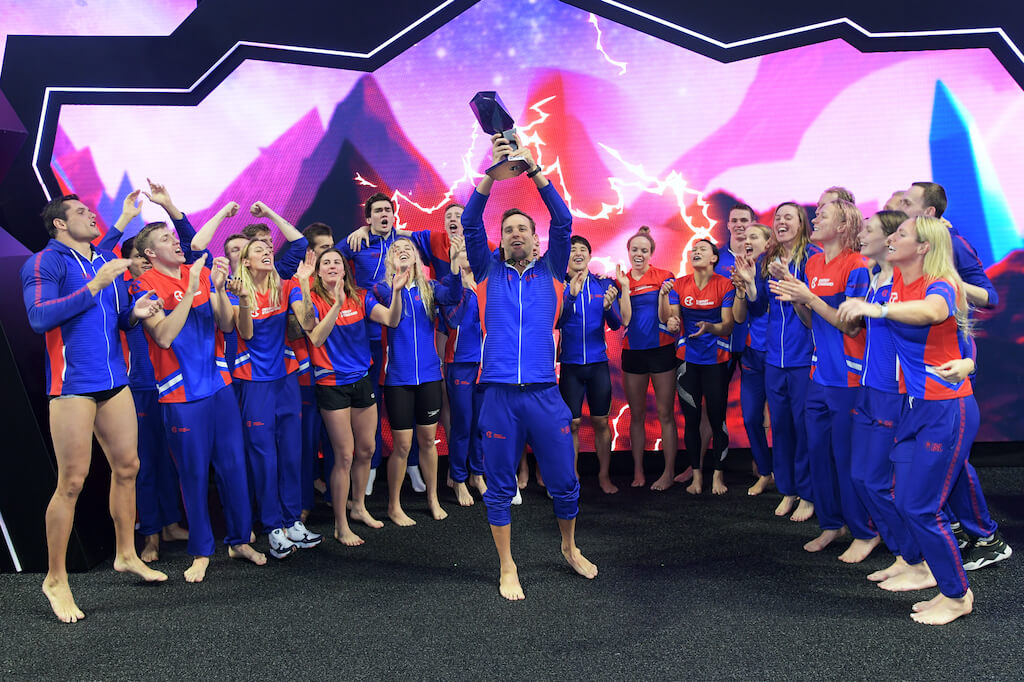
Over the coming three days, the Swimming World writing team will bring you its collated thoughts on the first season of the International Swimming League, after a first Final Match packed with thrills, spills and nail-biting finishes that showcased swimming as a sport of entertainment and potential long unlocked.
Our exercise takes a look at what we perceive as pros, cons (Pro et contra – for and against) and solutions that we recommend the League takes into account when holding its essential debrief.
Swimming World writers agree on most of what follows. There are nuances in the mix and some observations and proposed solutions raise more questions than they provide answers.
The point is not to have an argument but simply list the key observations of a team of writers that knows its swimming, is supportive of the League, the changes it has brought to a sport in need of a new model and a truly Pro-Athlete platform, but has kept a keen and balanced eye one step back from the obvious and entirely understandable gushing support from athletes, the coaches involved and, of course, the organisers of the League.
- Contributions from: Liz Byrnes, Dan D’Addona, Ian Hanson, Sabrina Knoll, John Lohn, Craig Lord, Andy Ross and a few wise folk who have spent the first ISL season at the water’s edge.
- We invite readers to join our exercise by posting comments at the end of this article or visiting our pages on Facebook, Twitter and Instagram to leave their own observations and views on the first League season
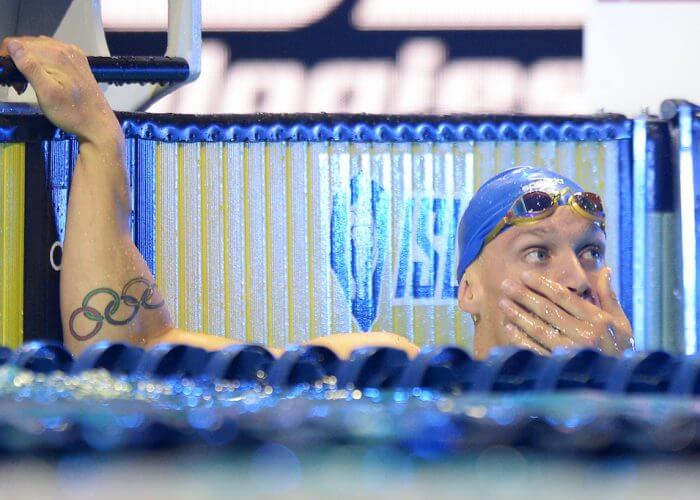
Caeleb Dressel – Las Vegas MPV – Photo Courtesy: Gian Mattia D’Alberto/LaPresse
Part 1: The Pros of a New World Of Pro-Team Swimming
New team format, new start for swimming, great athlete response, the fun and festival feel of it all, the lights and screens and stage-setters making it all look so fab, pumped-up intros, plus the engagement and enthusiasm of the most important folk under the lights, the athletes and coaches and managers making it all work, are among common themes in the following list of Pros that we’ve split into four main categories:
- Athlete Experience and Profile
- Coaches
- Ethics and Fair Play
- Format
NB: observations are in no particular order of importance
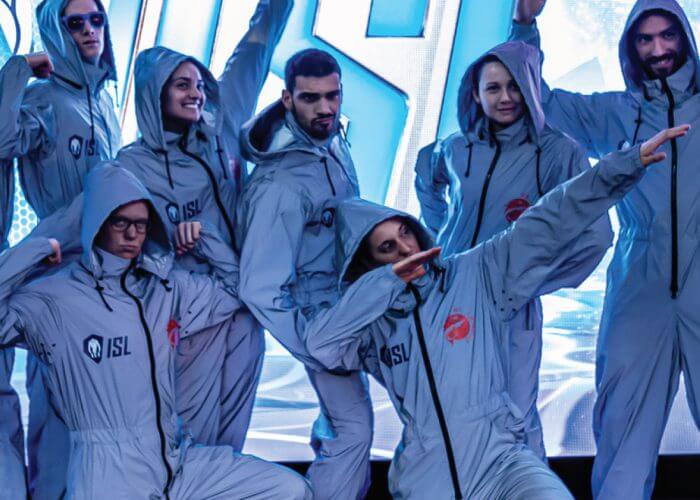
Supersuits of a different kind…
1. Athlete Experience and Profile
- Building fan interest in the sport in non-Olympic years and reaching out to a global audience beyond existing fandom
- The league has emboldened athletes and helped swimmers to become people in the eyes of a wider audience, rather than panting protagonists who only ever speak to their own lane in quick soundbites of “great race” “split was good” and “gutted”.
- The League has put the Athlete Voice in swimming on fast-forward, making swimmers more aware of their rights and expectations of a return win the investments in time and energy, the impact of which will last a lifetime.
- Swimmers willing to talk on issues beyond their own lane at a time when athlete contracts and team policy on national team duty instructs them to stick to their lane, which can have the effect of making the swimmer look robotic and sound boring to a wider audience. There is nothing boring about listening to Adam Peaty, Sarah Sjostrom, Cate Campbell, Tom Shields, Katinka Hosszu, Lilly King and many others expressed their honest opinions about the governance of their sport, doping and much else. Indeed, they shift the dynamic and the culture of the sport when they attract that wider audience interest each time they call out poor practices that work against the interests and welfare of athletes.
- The camaraderie and enjoyment visible in the athletes was very much different from what is seen at the Olympics, World Championships and other meets. There was a genuine investment in the team aspect of the competition – and national flags were not a part of the picture. There’s room for flags – and opportunities to grow without them.
- Top level swimmers getting the taste of swimming for a team and having in-season swims mean something in the long run. (Hearing Sarah Sjostrom say she was trying to watch everyone else’s swims in between her races when normally she is focusing on herself)
- It is extending swimming careers for pros who might have retired without this chance; a place for comebacks as we saw with Natalie Coughlin.
- Olympic podium placers and champions of yesteryear, such as Lenny Krayzelburg, Jason Lezak, Rob Woodhouse, Mel Marshall and James Gibson involved in management, coaching, direction and guests of honour … keeping such people in the sport engaged is an assist to swimming, a sport that has neither celebrated its heroes of the past nor invited them when the success of swimmers is being celebrated at key anniversaries and in relation to specific events.
- The inclusion of Rebecca Adlington, Karen Pickering and Mark Foster as analysts was a nice touch as they brought a professional vantage point to the coverage. Lead announcer Bernie Guenther (for ESPN coverage) did his homework and was eager in his play-by-play calls and observations.
- Sense of fun and lack of “all on the line” tension in individual swimmers provides a different environment, one in which the swimmer is not in the creature in the bubble but a human with their own mind, their own views, their own ways of expressing what they feel about their work place and how it all fits together.
- Athletes were out of the national-team/national-federation bubble in an environment that encourages them to grow up and extend their lexicon as adults capable of speaking about and listening to the world beyond their “own lane”.
- The vast majority of the biggest names in the sport participated in the ISL, a demonstration that the intrigue to compete was there and the athletes took advantage of an opportunity that had been long desired.
2. Coaches
- Watching “traditional” coaches, experts in college and duel meet tactics, such as Gregg Troy and David Marsh get invested in the meet and saying stuff like “we let some points get away from us in that last race”. They’ve brought the best of NCAA to the cream of the crop of elite swimming and been met by the enthusiasm of coaches like James Gibson, Mel Marshall, David Lush who come at team events from a different angle. The alchemy of it has been fascinating and is brimming with potential.
3. Ethics and Fair Play
- Equal pay for men and women
- Zero tolerance on swimmers with doping records
Lilly King and fellow queens of the Condors celebrate medley relay victory in Las Vegas – Photo Courtesy: Fabio Ferrari/LaPresse
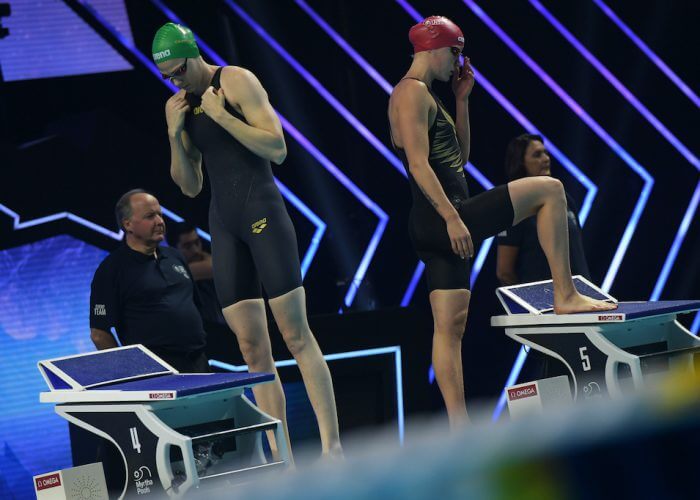
Cate Campbell, left, and Sarah Sjostrom prepare for the decisive skins head-to-head – Photo Courtesy: Gian Mattia D’Alberto/LaPresse
4. Format
- Meets maximised at 2 hours, no long prelims that puts a wider audience off the sport seen to be locked in an old world of ‘doing things because they’ve always been that way’.
- Having athletes from smaller countries like Sarah Sjostrom, Chad Le Clos and Alia Atkinson be able to experience being on competitive relays.
- The silver ‘spacesuits’/onesies: it kind of summed up what the league is. As Ryan Murphy put it: “It’s flashy, its unique, it’s thinking differently and learning how to embrace it.”
- The idea with the team boxes is a plus, as well as the team apparel of course, the team cheers and moves. “Team” truly felt it meant something
- Short-course metres is generally more exciting
- The Skins have been heavily entertaining. Extremely interesting to watch how everyone recovers in between rounds. It sends athletes and coaches back to base with a deeper yet more blunt understanding about where they need to step up.
- The graphics and logos featured in the television presentation were sharp.
- It is a great fan experience in person with fast racing, energy and pyrotechnics
- Having former swimmers be General Managers brings a sense of history and connecting generations
- Moving the competitions to various locales was a positive and served as a way to generate fan interest in a handful of cities. Having the championship meet in a locale such as Las Vegas was excellent from a promotional sense and gave teams something to chase. Keeping the meet in that location would be wise for the future and could be denoted as, “The Road to Vegas.”
- The athlete introductions were well done and, as a result, made it clear who was competing for each team.
- The camera work during the three-minute breaks during the Skins competitions revealed the toll a 50m freestyle can have on an athlete. It was intriguing just watching the athletes trying to catch their breath and ready themselves both physically and mentally for the next race.
- There was an edge of tension about it all.
- Broadcasts occasionally provided a head-to-head graphic that highlighted a matchup between two stars. This “Tale of the Tape” approach was catchy and added a bit to the upcoming race.
- Having the two teammates swim next to each other in designated lanes throughout the sessions made it easy to follow a specific team.
Infancy of the League
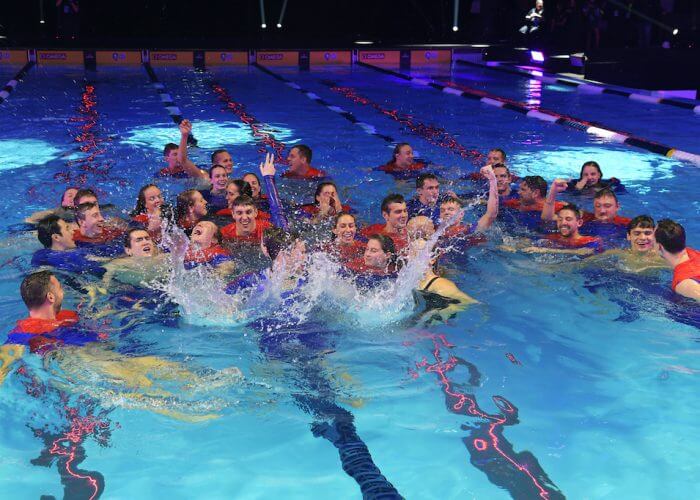
Energy Standard take a dip – Photo Courtesy: Gian Mattia D’Alberto/LaPresse
Think back a little over two years and the concept of International Pro-Team in swimming was in its infancy. Back when Energy Standard’s boss Konstantin Grigorishin was a wealthy man backing the establishment of a professional elite team of swimmers from various countries, with a youth/club wing bringing youngsters such as Kliment Kolesnikov and Mykhailo Romanchuk together in junior competition with athletes from all over Europe in a specific ‘team’ concept and an aim of growing the individual and delivering a message of ‘no-tolerance’ on doping and much else, the League was not in the swimming Lexicon. It is now – and how. What unfolded a year ago in London as the ISL was born and leading swimmers stood together and backed the birth of a new chapter for them and their sport, led to what just unfolded over the past 10-12 weeks. Yes, there is room for improvement, some things have not worked well and need careful thought but… Wow, look at the revolution that has gone down in swimming in a timeframe that puts every other change in swimming in the past half a century at least in the shade. This is a truly significant moment.
Tomorrow: The ‘downside’ of Season 1 or … where there’s room for improvement.





Kurt Hanson needs to be on the coverage . He has a much better knowledge of details of the swimmers. Too much was missed by the commentators I was watching in Australia. All hype but no substance as someone else said .